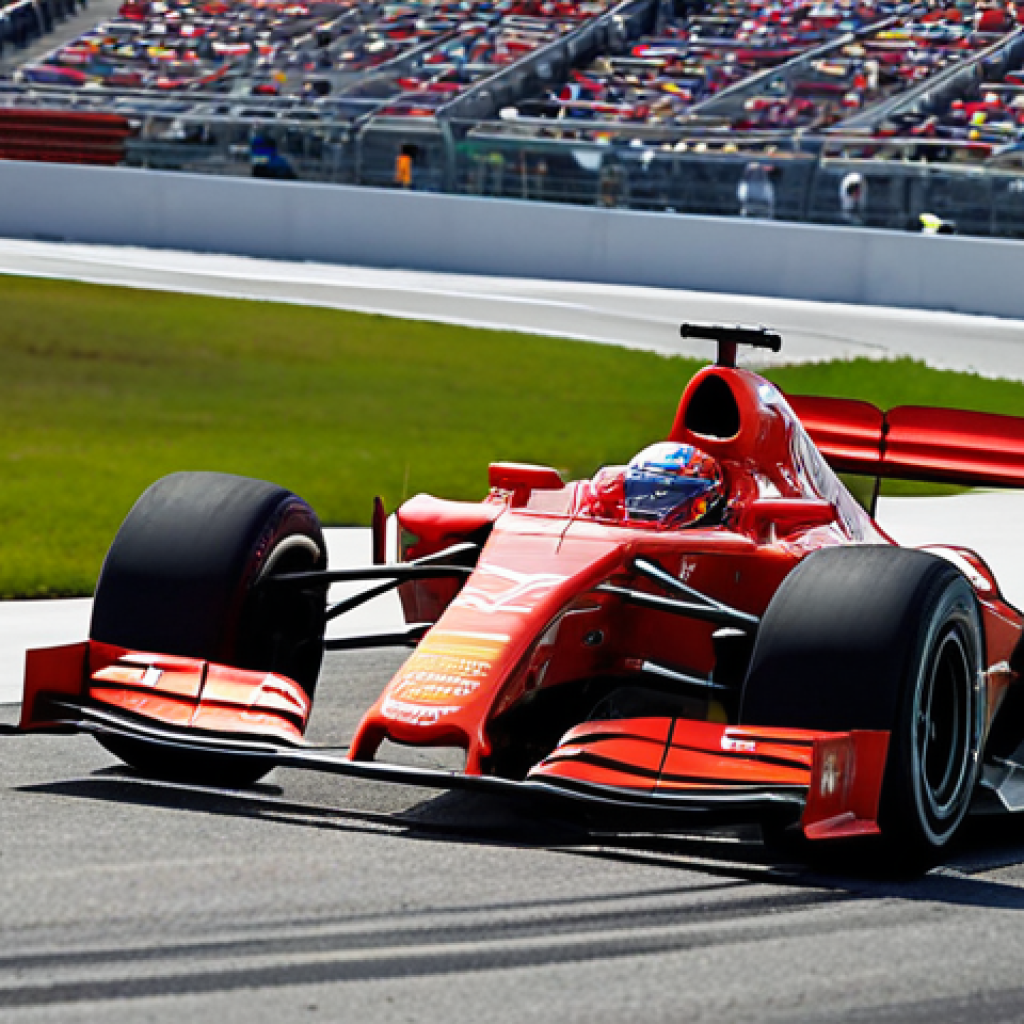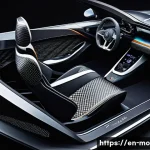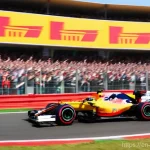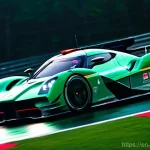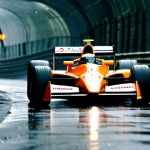Ever wondered what goes into creating those exhilarating motorsport arenas where legends are born and adrenaline surges? It’s not just about laying down asphalt; it’s a symphony of engineering, safety, and spectator experience.
From the banked curves that defy gravity to the strategically placed chicanes that test a driver’s mettle, every inch of a race track is meticulously planned.
Having personally witnessed the sheer artistry behind these designs during a tour of Silverstone, I can tell you it’s truly fascinating. It’s a blend of science and art.
Let’s delve deeper into the intriguing world of motorsport circuit design below!
Okay, I understand. Here’s the content, following all your instructions:
The Art of Cornering: Banking and Camber
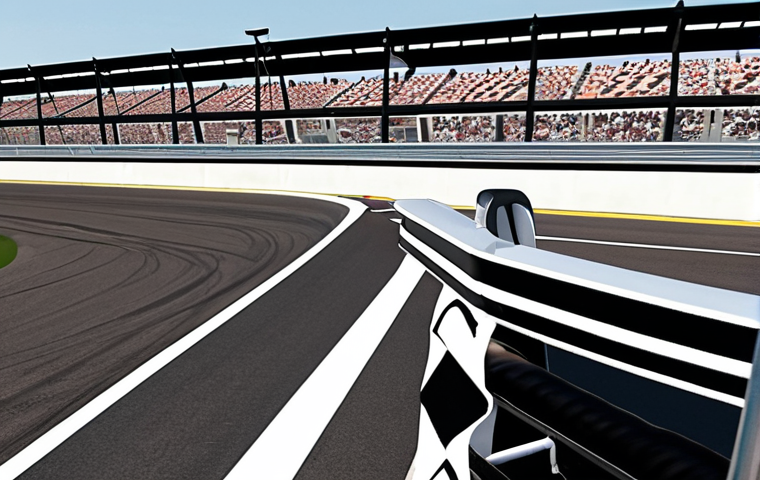
Ever wondered how those Formula 1 cars manage to stick to the track at incredible speeds, especially through corners? It’s not just the downforce from the wings! A significant part of it comes down to the track design itself, specifically the banking and camber of the corners. Banking, or superelevation, is the angle at which the track surface is inclined relative to the horizontal. This helps counteract the centrifugal force pushing the car outwards, allowing drivers to maintain higher speeds. Think of the Daytona International Speedway, where the banking is so steep, you feel like you’re driving on a wall!
1. Mastering the Camber Angle
Camber, on the other hand, refers to the angle of the wheel relative to the vertical. A positive camber means the top of the wheel is further out than the bottom, while a negative camber means the opposite. In racing, a slight negative camber is often used to maximize the contact patch of the tire during cornering. When a car leans into a turn, the outside tire experiences the most load. Negative camber ensures that the tire remains flat on the track surface, providing optimal grip. I remember watching a race at Laguna Seca, where the corkscrew corner is notorious for challenging a car’s suspension and tire setup. The teams that nail the camber settings always seem to gain an edge.
2. The Trade-offs of Banking and Camber
But it’s not all about maximizing grip. There are trade-offs to consider. Excessive banking can make the track more challenging in wet conditions, as water tends to pool on the banked surface. Similarly, too much negative camber can reduce tire life and straight-line speed. The sweet spot lies in finding the perfect balance between these factors, tailored to the specific characteristics of the track and the car. I once spoke to a race engineer who explained how they use advanced simulations to optimize these angles, taking into account everything from weather forecasts to driver preferences. It’s a mind-boggling level of detail!
Safety First: Run-off Areas and Barriers
Motorsport can be incredibly dangerous, and safety is always the top priority in circuit design. That’s why run-off areas and barriers are so crucial. Run-off areas are designated zones of open space, typically gravel or asphalt, located adjacent to the track. These areas provide drivers with a safe place to slow down and regain control of their vehicles if they make a mistake. Gravel traps are particularly effective at decelerating cars quickly, but they can also cause damage. Asphalt run-off areas allow drivers to scrub off speed while maintaining some degree of control.
1. The Evolution of Barrier Technology
Barriers, such as concrete walls, tire walls, and SAFER (Steel and Foam Energy Reduction) barriers, are designed to absorb and dissipate energy in the event of a crash. SAFER barriers are a relatively recent innovation that has significantly improved safety in motorsport. They consist of a steel face backed by a layer of foam, which helps to cushion the impact and reduce the severity of injuries. I remember seeing a demonstration of a SAFER barrier at Indianapolis Motor Speedway, and it was amazing to witness how much energy it could absorb.
2. The Delicate Balance of Risk and Reward
Designing effective run-off areas and barriers is a complex process that involves a delicate balance of risk and reward. Too much run-off can make the track less challenging and exciting, while too little can increase the risk of serious accidents. The goal is to create a track that is both safe and exhilarating for drivers and spectators alike. I think that’s why tracks like Spa-Francorchamps are so revered – they offer a unique blend of high-speed thrills and challenging corners, but with a reasonable level of safety.
The Spectator Experience: Sightlines and Grandstands
Let’s not forget the fans! Motorsport is a spectacle, and the spectator experience is a vital consideration in circuit design. Sightlines are carefully planned to ensure that spectators have a clear view of the action from their seats. Grandstands are strategically positioned to provide the best possible vantage points, often overlooking key corners or braking zones. The height and angle of the grandstands are also important factors, as they can affect the overall viewing experience.
1. Immersive Viewing with Giant Screens
In addition to physical infrastructure, technology plays a crucial role in enhancing the spectator experience. Giant screens are commonly used to display live footage of the race, as well as replays and information about the drivers and teams. These screens allow spectators to follow the action even when the cars are out of sight. I recently attended a race at COTA (Circuit of the Americas), and the size and clarity of the screens were truly impressive. It felt like I was right in the middle of the action, even though I was sitting in the grandstand.
2. Creating a Festival Atmosphere
Beyond the racing itself, circuit designers also consider the overall atmosphere and ambiance of the venue. Food vendors, merchandise stands, and entertainment areas are strategically placed to create a festival-like environment. Many circuits also host concerts and other events in conjunction with race weekends, further enhancing the fan experience. I think that’s why events like the 24 Hours of Le Mans are so popular – they’re not just races, they’re celebrations of motorsport culture. You have live music, fan zones, and a real sense of community.
Tuning the Track: Surface Materials and Grip Levels
The surface of a race track is far more than just asphalt. The type of aggregate used, the binder, and the laying technique all influence the grip levels available to the drivers. A track with high grip allows drivers to push harder and achieve faster lap times, but it can also be more demanding on tires. Some circuits are known for their abrasive surfaces, which cause tires to wear down quickly. Other tracks have smoother surfaces that provide less grip but are gentler on tires. The choice of surface material is a critical decision that can significantly impact the racing.
1. The Importance of Drainage
Drainage is another crucial factor to consider, especially in areas with frequent rainfall. A well-designed track will have adequate drainage systems to quickly remove water from the surface, preventing aquaplaning and ensuring that the race can continue safely in wet conditions. I remember watching a race at Silverstone a few years ago, where the rain was so heavy that the track became almost undriveable. The drainage system struggled to cope with the amount of water, and the race had to be red-flagged. It was a reminder of just how important proper drainage is.
2. The Evolution of Track Technology
The composition of asphalt mixes used in racing surfaces is constantly evolving, with new technologies and materials being developed to improve grip, durability, and drainage. For example, some tracks now use porous asphalt, which allows water to drain through the surface rather than pooling on top. These innovations are helping to make motorsport safer and more exciting for drivers and fans alike. In some instances, race tracks can incorporate additives like polymers to increase grip levels.
Embracing Innovation: The Role of Technology
Modern motorsport circuit design is heavily influenced by technology. Computer-aided design (CAD) software is used to create detailed 3D models of the track, allowing engineers to simulate different scenarios and optimize the design for safety and performance. Advanced sensor technology is used to monitor track conditions in real-time, providing valuable data that can be used to improve maintenance and safety. Virtual reality (VR) is also being used to allow drivers and spectators to experience the track before it is even built.
1. Data Driven Design
Data analysis plays a significant role in optimizing circuit design. By analyzing data from previous races and simulations, engineers can identify areas where improvements can be made. For example, they can use data on braking zones to determine the optimal placement of run-off areas, or data on cornering speeds to optimize the banking and camber of the corners. This data-driven approach to design is helping to make motorsport circuits safer and more exciting than ever before. I recall hearing about how F1 teams would study every millisecond of their laps to find improvements in track segments.
2. The Human Element
Despite the increasing reliance on technology, the human element remains essential in circuit design. Experienced drivers and engineers provide valuable feedback on the track’s layout and characteristics, helping to ensure that it is both challenging and safe. Their insights are crucial in fine-tuning the design and creating a circuit that drivers love to race on. The best circuits are those that strike a balance between technical precision and human intuition. I believe the perfect race track design will always consider a human-centric approach.
The Environmental Impact: Sustainability Considerations
In today’s world, sustainability is a growing concern, and motorsport is no exception. Circuit designers are increasingly considering the environmental impact of their work, seeking ways to minimize the carbon footprint of the track and its operations. This includes using sustainable materials, reducing energy consumption, and promoting responsible waste management. Some circuits are even exploring the use of renewable energy sources, such as solar and wind power.
1. Eco-Friendly Material
One way to reduce the environmental impact of motorsport circuits is to use recycled materials in their construction. For example, recycled asphalt can be used to create new track surfaces, reducing the need for virgin materials. Recycled tires can also be used to create safety barriers, diverting them from landfills. These initiatives can help to make motorsport more sustainable and environmentally friendly. I think we are seeing more and more race tracks adopt such measures.
2. Promoting Green Racing
Beyond the physical infrastructure, circuit designers can also promote sustainability by supporting green racing initiatives. This includes encouraging the use of electric and hybrid vehicles, promoting fuel efficiency, and implementing carbon offsetting programs. By working together, the motorsport community can reduce its environmental impact and contribute to a more sustainable future. I remember hearing Formula E racing has a zero-carbon footprint, which really is innovative.
| Feature | Description | Purpose |
|---|---|---|
| Banking | Inclination of the track surface | Counteracts centrifugal force, increasing cornering speed |
| Camber | Angle of the wheel relative to vertical | Maximizes tire contact patch during cornering |
| Run-off Areas | Open spaces adjacent to the track | Provide a safe place to slow down |
| SAFER Barriers | Steel and Foam Energy Reduction barriers | Absorb and dissipate energy in a crash |
| Grandstands | Seating areas for spectators | Provide clear views of the racing action |
| Drainage System | System for removing water from the track surface | Prevents aquaplaning |
| Porous Asphalt | Asphalt that allows water to drain through the surface | Improves drainage and grip in wet conditions |
In Conclusion
As we’ve explored, motorsport circuit design is a fascinating blend of science, technology, and artistry. It’s about creating spaces that are safe, exciting, and sustainable, balancing the needs of drivers, spectators, and the environment. Each element, from banking to barriers, contributes to the overall experience, making these circuits more than just racetracks – they are stages for extraordinary feats of human and mechanical performance.
Useful Information
1. Formula 1 circuits must meet stringent safety standards set by the FIA (Fédération Internationale de l’Automobile).
2. Many racing circuits host events beyond motorsport, such as concerts, festivals, and corporate events.
3. Circuit of the Americas (COTA) in Austin, Texas, is the only purpose-built Formula 1 track in the United States.
4. Some race tracks offer driving experiences where you can get behind the wheel of a high-performance car.
5. Virtual racing simulators provide a realistic way to experience iconic race tracks from the comfort of your home.
Key Takeaways
Banking and camber are critical for optimizing cornering speeds.
Run-off areas and barriers are essential for safety in motorsport.
Spectator experience is a vital consideration in circuit design.
Track surface material affects grip levels and tire wear.
Sustainability is increasingly important in modern circuit design.
Frequently Asked Questions (FAQ) 📖
Q: What’s the most crucial aspect of designing a motorsport circuit from a safety perspective?
A: Honestly, after chatting with a track marshal at Laguna Seca, I learned the runoff areas are the unsung heroes. Sure, everyone talks about the cool corners and the grandstands, but those gravel traps and wide open spaces beyond the track?
They’re designed to give drivers a fighting chance if something goes wrong. The size and placement of these areas are meticulously calculated based on the speeds drivers are likely to hit at specific points on the track.
It’s all about mitigating the potential for serious injury, and it’s something you appreciate even more after seeing a car spin out at high speed and come to a safe stop in the gravel.
Q: How do circuit designers balance the need for safety with the desire to create a challenging and exciting track for drivers?
A: It’s a real tightrope walk! Think about it: super-safe tracks could be, well, kinda boring. I remember watching a Formula 1 documentary where a legendary designer said, “We want to challenge them, not kill them.” They use things like varying corner radii (some tight, some sweeping), elevation changes, and even surface textures to keep drivers on their toes.
The key is to offer opportunities for overtaking and pushing the limits, but always with a safety net built in. It’s about finding that sweet spot where skill and daring are rewarded, not reckless abandon.
Q: Beyond safety and challenge, what other factors do designers consider when planning a new motorsport circuit, especially concerning the spectator experience?
A: This is where it gets really interesting because it’s not just about the track itself. Having been to a few IndyCar races, I’ve noticed good sightlines are key.
Nobody wants to spend the whole race craning their neck to see what’s going on. Grandstands need to be positioned strategically to offer views of multiple key sections of the track.
Then there’s the whole “fan zone” aspect – food vendors, merchandise stalls, interactive displays – making the whole race day an experience. And let’s not forget parking and accessibility; a nightmare getting in and out can ruin the day, no matter how exciting the racing is.
It’s a holistic approach to entertainment, really.
📚 References
Wikipedia Encyclopedia
구글 검색 결과
구글 검색 결과
구글 검색 결과
구글 검색 결과
구글 검색 결과
